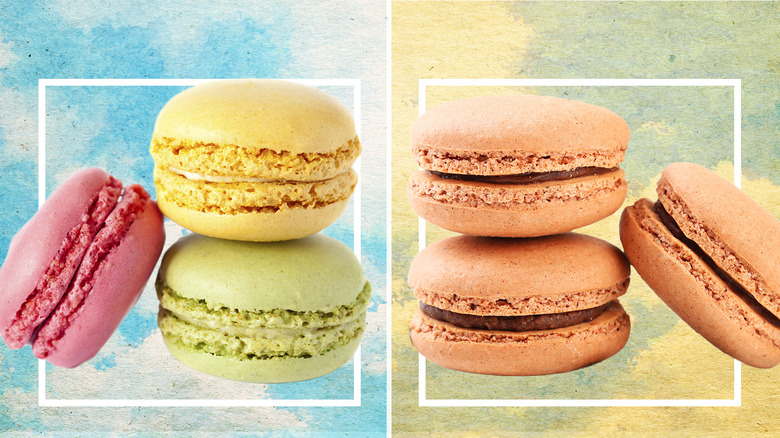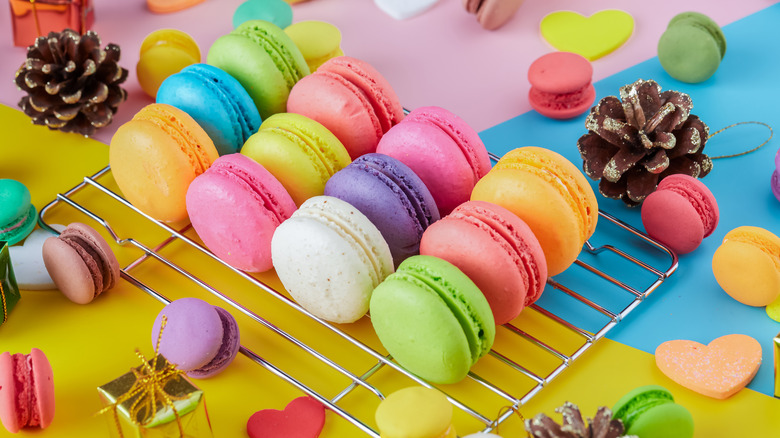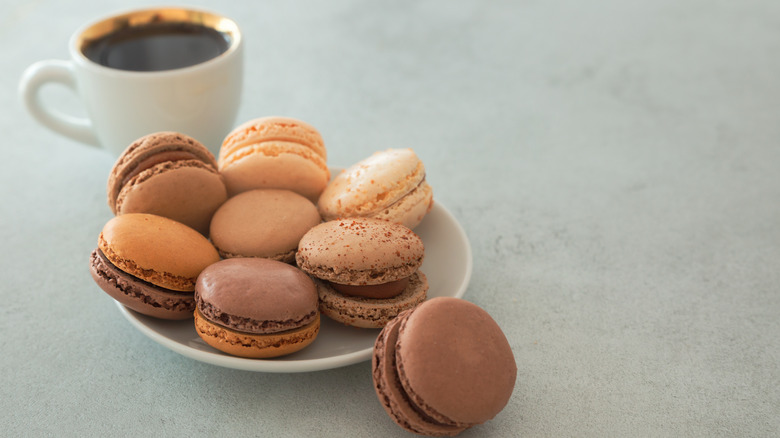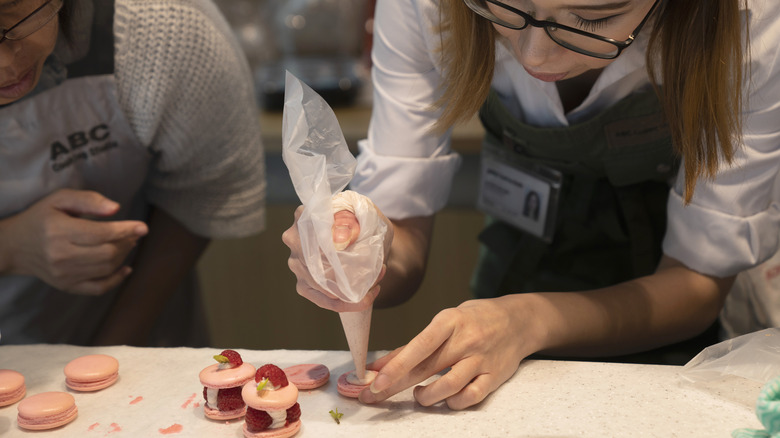The Difference Between French And Italian Macarons
Think you know a macaron when you see one? You probably do –– but can you tell the difference between a French macaron and an Italian one? With the brilliant colors, luscious fillings, and meringue-based layers of light, crispy shells, it's hard to miss these standouts in a bakery or specialty aisle of a grocery store. Both countries have perfected the culinary art of macaron creation, leading to interpretations across the globe, including ones in Switzerland, the United States, South Korea, and Japan.
Once upon a time, only a true pastry expert could spot the intricate details defining and differentiating Italian and French macarons. There are indeed many subtleties involved, but a quick side-by-side glance reveals a lot, at least in terms of appearance. In a nutshell (or cute little pastry shell), the most detectable difference is that the French version is typically flatter with more obvious uneven air bubbles in the shells, while its Italian counterpart rises taller with cleaner edges and smaller air pockets.
But the more intricate characteristics are what matter most, even when they're not visible in exterior presentation. The varying ingredients and composition techniques result in considerable changes to texture and flavor, particularly the sweetness levels. Whether purchasing these little lovelies in a bakery or venturing to make them at home, knowing these distinctions can lead to macaron expertise.
What is a French macaron?
The colorful petite macaron gets elevated culinary status because of its French connection, but the pastry potentially has centuries-old roots in various cultures, including Arab-style almond macarons as far back as the 9th century. It's widely believed that Queen Catherine di Medici introduced an Italian version of macarons when marrying into French royalty during the 1500s.
The French macaron we know and love today evolved at the hands of French chefs over many generations, spreading past the palace gates and eventually into the population at large. One tale ties this proliferation to a pair of French nuns surviving the French Revolution by making macarons to sell, earning the moniker of the "Macron Sisters." That early version from the 18th century was reportedly round and flat, thus cheekily called a priest's bellybutton.
Eventually, French chefs in the early 1900s transformed macarons into double-decker beauties filled with any variety of sweet jellies, buttercream, and delicacies such as chocolate ganache. Similar to its Italian Doppelganger, the French macaron is based on almonds, typically ground to a flour-like powder that defines its preparation –– though in a different way than the Italian approach.
What is an Italian macaron?
Catherine de Medici's Italian heritage from the infamous Medici family lends credence to privileged stories of her bringing along a favored pastry when departing Italy for royal life as the Queen of France. However, before French chefs put their mark on macarons, it's possible they arrived as a version of Italian Pignoli, which similarly employs almond paste, but is named for its pine-nut coating. Regardless, some Italian accounts of macarons date them to ancient monasteries of the Middle Ages.
It's important to note that a very similarly named Italian cookie-like dessert, the macaroon, is completely different than the delicate, colorful macaron. An extra vowel is all that separates them linguistically, but the disparity in ingredients, taste, and texture is vast. A macaroon is thick, large, chewy, and defined by its signature component, shredded or flaked coconut. If almonds are present at all, they're chunkier and more prominently displayed.
On the other hand, drop that extra "o" in the spelling, and you'll have a light, petite Italian macaron awash in a rainbow of colors. It's almost identical to the French macaron in appearance, except for the added height and smoother finish –– but there's more than meets the eye in these dueling European delicacies.
Difference in macaron techniques and ingredients
Calling a macron a cookie would likely be an insult to bakery chefs, especially given the level of care and expertise involved in making them. Regardless of whether the patisserie resides in France or Italy, the process of making macarons is one to be admired and mastered, even when imitated across the pond in America. Here's the main difference in technique and ingredients.
The primary components seem the same at first glance: egg whites and sugar. But that's where the similarities end. A French chef, or anyone making a French-style macaron, will almost always use raw egg whites and a fine granulated sugar, typically white and processed rather than a coarse or crystalized brown version. Those two ingredients morph into puffy, airy merengue when whisked into stiff peaks, which then take absorb the ground almond flour and other chosen additives such as powdered sugar.
The Italian way of making macarons is a bit more complex, as it employs a warm sugar syrup that actually cooks the egg whites when whipped. The result is a sturdier macaron due to fewer air pockets. Both versions take a precise level of care; the French one retains more air, risking deflation if overbeaten, while the Italian process requires more care and a careful balance of hot syrup to uncooked egg whites, typically using a electric kitchen mixer of some sort.
Italian macarons lean sweeter while French ones are chewier
Sweetness is a given for a dessert centering on sugar, regardless of whether it's granulated or turned in a melted syrup. That means that both French and Italian macarons aren't just a pretty face –– they satisfy a sweet tooth by most anyone's standards. However, one version actually does hit the tongue with a sweeter love-punch. That would be the one coming from Italy.
The concentrated, melted sugar syrup in Italian macarons undeniably results in a sweeter taste than French ones made with unheated granulated sugar. Both versions have fans who notice even the slightest variations, but when it comes to sweetness, there's another thing to consider. When sugar isn't foremost on the tastebuds, it leaves room for a more earthy, almond-forward flavor. That's a plus for the French, if you like more substance than fluff.
Just remember that a large percentage of flavor in macarons comes from the filling rather than just the sugar. Italian and French chefs, as well as ones in Switzerland, the United States, and other macaron-loving regions, customize their creations with everything from raspberries to salted caramels, pistachios, cherries, tiramisu, vanilla, and ganache, and there's even a recipe for pumpkin spice macarons.
Finally, there's the consideration of texture and mouth feel. Since French macarons retain more air and more moisture during preparation, they tend to be deliciously chewier with a softer texture. Italian versions, conversely, are crisper and lighter, often delightfully crumbling at first bite.




